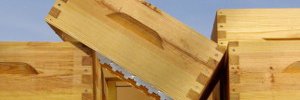Nous vous proposons de vous inscrire à nos listes de diffusion. Vous serez alors tenus informés de l’évolution de notre disponible.
Struggling against diseases
As a consequence of our good behaviour (very fast rotation of the frames and 90% of our queens are less than 1 year old), we maintain a low rate of diseases in our colonies.
Foul brood:
The cases of American Foulbrood are very rare (1% to 2%). They generally appear at the beginning of winter, on the weak colonies of the previous year- Apiaries’ intoxication cases (supposed or proved).
We often find them on hives that had impressive results the preceding season.
Why? We know that the prevalence is very important in the south-west area of France. In fact, a 2010 study realized by INRA from Montpellier showed that there are Paenibacillus larvae spores in 10% of apiaries and in over 80% of hives.
-* The cases of European Foulbrood are a bit more frequent (3% to 5%). They generally appear between the acacias and sweet chestnuts blossoms.
-* Black disease: we usually notice some symptoms of this disease on our apiaries at the end of summer. Some of our colonies are very affected by this disease letting many bees on the alighting-board. Unfortunately, it often touches the best hives. It is closely related to the pedigrees.
-* Nosema Ceranae: according to what we read on the subject, we suspect Nosema Ceranae to weaken a lot our colonies. It especially happened during the 2008 season.
Treatments:
We never use any kind of antibiotics, neither for Foulbrood cases nor for Nosema (Fumidil, Fumagiline).
-* Foulbrood cases: We consistently burn all the frames. We only kill the queen bee if she is more than 6-month old. The colonies usually come back to normal very quickly. Until now, the relapse cases are very rare.
-* Nosema Ceranae cases: since we have modified our summer treatments against varroa, our colonies reveal a good dynamics during the whole season. We noticed that there was a significant link between the treatment’s effectiveness in August and the pressure of Nosema the next season. Varroas and associated virus weaken the immune defence system of the bees, which make them more vulnerable to the parasite, still a little pathogenic. However, even if the winter treatment is really effective, it strangely doesn’t seem to have repercussion on Nosema.
Other solutions:
-* Recent studies revealed the important role of the lactic bacteria on the bees’ immune system.
-* Propolis utilisation: Some apiculturists from Argentina had tested the addition of propolis to the syrup for nourishment. They got good results on the American Fullbrood and on Varroa.
A study in vitro made in Brazil and published in 2008 proved the significance of propolis concentration. Above all, this study brought different answers on the origin of propolis.





